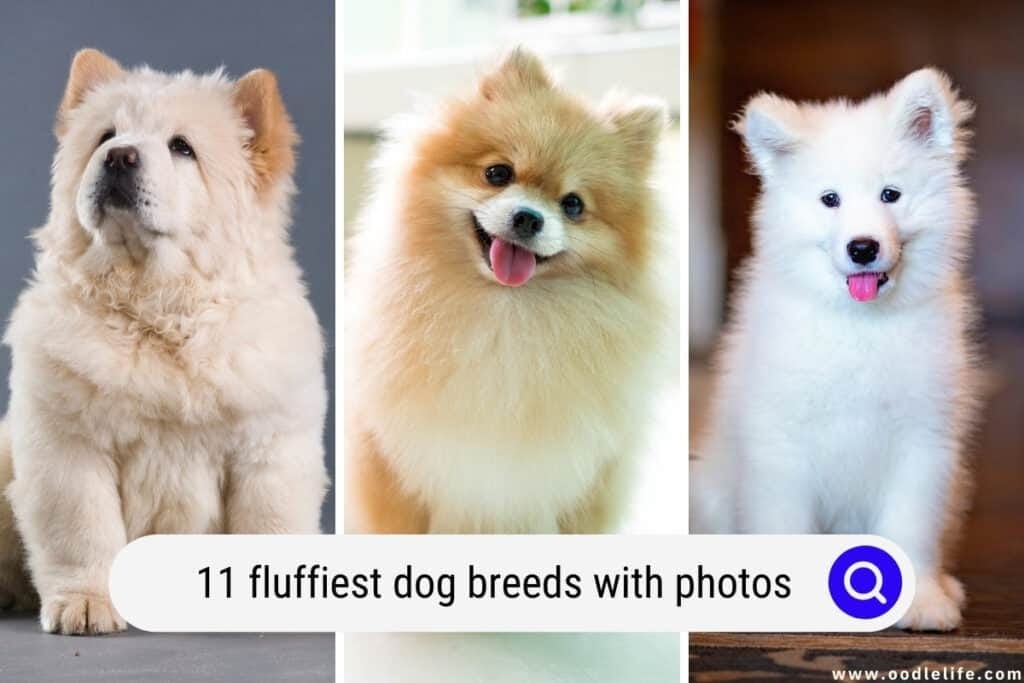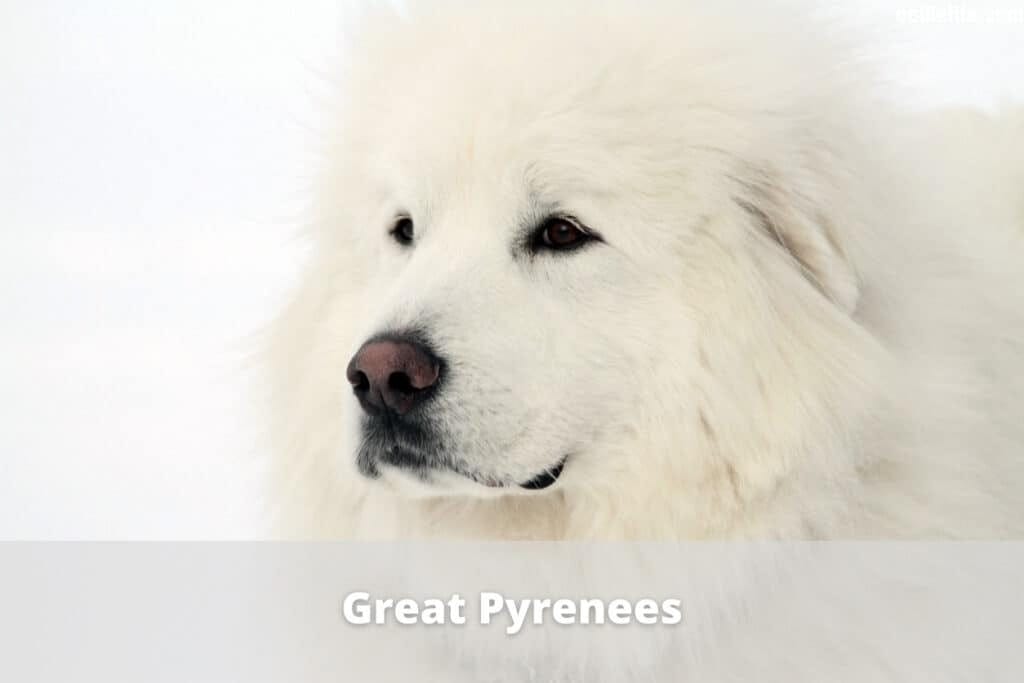- OodleLife
- Posts
- 11 FLUFFIEST Dog Breeds (with Photos!)
11 FLUFFIEST Dog Breeds (with Photos!)
Fluffy dogs are everyone’s favorite, there’s no denying it. There are very few things in this world more adorable than then canines that look like little walking clouds of fluff.
Even people who claim to be “cat people” can’t resist the charms of a big, puffy pooch. There are many reasons why fluffy dogs are so popular. For one thing, they’re incredibly adorable.

Those soft, cuddly coats just beg to be petted, and who can resist those big, innocent eyes?
But there’s more to it than just cuteness. Fluffy dogs also tend to be gentle and good-natured, making them great companions for both children and adults.
If you are looking for the 11 “most-likely-dogs-to-be-mistaken-for-a-plush-toy”, here they are!
1. Samoyed
There are few dogs as immediately recognizable as the Samoyed. With their thick, glossy fur coats and signature white color, they’re one of the most distinctive breeds around. But there’s more to the Samoyed than just their good looks.

They’re also gentle, playful, and devoted companions, making them ideal family pets. And thanks to their thick coats, they’re well-suited to colder climates – perfect for those who live in areas with harsh winters.
2. Tibetan Mastiff
These gentle giants are known for their protective instincts, and they make excellent guard dogs. They are also incredibly intelligent, making them easy to train. However, they are not the right breed for everyone.

Tibetan Mastiffs require a lot of exercise, and they are not well suited to apartment living. They also tend to be aloof with strangers, so they may not be the best choice for families with small children. But if you’re looking for a devoted companion who will always have your back, the Tibetan Mastiff is the perfect breed for you.
3. Old English Sheepdog
Old English Sheepdogs are a relatively rare breed of dog, originating in England. They were originally bred to be working dogs on farms, herding sheep and other livestock. Today, they are more often seen as companion animals and family pets.

These dogs are large and muscular, with thick, fluffy coats that can be either blue-gray or gray-white. They have long, shaggy hair that covers their eyes, and they are known for being very gentle and good-natured. Old English Sheepdogs are intelligent and easily trained, making them great pets for families with children.
4. Bearded Collie
The ultimate shaggy dog, Bearded Collies, or “Beardies” as they are sometimes called, are a Scottish herding breed of dog. They were used for herding sheep and cattle on Scottish farms. The Bearded Collie is a large dog, often reaching heights of 22 inches (56 cm) or more.

The Bearded Collie has a shaggy coat that can be any color or combination of colors. The most common colors are black, blue, brown, and fawn.
The Bearded Collie is an intelligent breed that is easy to train. They are also known for being very loyal and affectionate dogs. Being herding dogs, Beardies are active dogs that need a lot of exercise.
5. Chow Chow
Chow Chows are one of the oldest breeds of dogs, dating back to at least the Han Dynasty in China. They were originally bred as hunting dogs, but their thick fur made them more suitable as working dogs in colder climates.

Chow Chows were brought to Europe in the late 1800s, where they became popular as pets and show dogs.
Today, Chow Chows (and distinctively blue tongue!) are still popular as pets, although they can be difficult to train and care for. They are also used as working dogs in some parts of the world, and their thick fur makes them well-suited for colder climates.
6. Bichon Frise
The Bichon Frise is a small, cheerful dog that has its origins in the Mediterranean region. The exact history of the breed is somewhat unclear, but it is thought to be a descendant of the Barbet or Water Spaniel.

The Bichon Frise is a small dog, weighing between 8 and 12 pounds. They are very affectionate and love to be with their people. Bichons are known for their cheerful dispositions and are often referred to as “clowns of the dog world.”
They are intelligent dogs and are relatively easy to train.
The Bichon’s coat is soft and fluffy, and can be either white or cream. The breed does not shed much but requires regular grooming and a haircut every once in a while.
7. Great Pyrenees
The epitome of a livestock guardian dog, the Great Pyrenees are gentle giants who love nothing more than being around their family and friends. Gentle and loving, the Great Pyrenees make great family pets and are very loyal to their family.

The Great Pyrenees are thought to have originated in Central Asia and were brought to Europe by the nomadic people who inhabited the region. The Great Pyrenees was first recognized as a breed in France in the 16th century and was used by shepherds to protect their flock from predators such as wolves. The breed was later introduced to North America in the late 19th century and became a popular farm dog.
Great Pyrenees are large dogs, weighing anywhere from 100 to 150 pounds. They are very strong and have a thick, double coat that is white with possible markings of gray, tan, or brown.
8. Keeshond
The Keeshond is a German Spitz breed of dog that shares ancestors with other German Spitz breeds, including the Wolfspitz and Pomeranian.

The Keeshond is a medium-sized dog with a thick, double coat that is usually black and silver, but can also be gray and silver, or black and cream. The coat is very dense and coarse, with a thick undercoat and a longer outercoat.
The hair on the head is usually shorter than on the body, and there is a ruff of hair around the neck. The ears are small and pointy, and the eyes are dark brown.
The Keeshond is an active dog that needs plenty of exercise. They are intelligent and trainable, but can also be independent and stubborn. They are good watchdogs and will bark to alert their owners of strangers or unusual noises.
9. Newfoundland
The Newfoundland is a large, working dog breed originating from the island of Newfoundland. The history of the Newfoundland dog is a long and proud one. These dogs were used by fishermen in Newfoundland, Canada to help haul in nets and catch fish.

They were also used to help haul wood from the forest. Newfoundland dogs are strong swimmers and have a natural love for the water.
Today, Newfoundlands are also known for being gentle, patient, and good with children. They make great family pets and are often used as therapy dogs.
The Newfoundland is a large dog breed, weighing anywhere from 100 to 150 pounds. They are muscular and have a thick coat of fur that is waterproof. This breed is known for their webbed feet, which help them swim well. They also have a very strong sense of smell.
10. Pomeranian
The Pomeranian is a small but spunky little dog. Bred in the Pomerania region of Germany and Poland, these dogs were once used as herders and working dogs. But, today they are known for being one of the most popular companion breeds.

Pomeranians are intelligent, outgoing, and playful. But, they also have a bit of a stubborn streak. So, they require consistent training and socialization from an early age.
This breed typically weighs between 3 and 7 pounds and stands between 8 and 11 inches tall. They have a thick, double coat that can be either straight or curly. The most popular coat colors include orange, black, and brown.
11. Shetland Sheepdog
The Shetland Sheepdog, also known as the Sheltie, is a small to medium-sized breed of herding dog. The breed originated in the Shetland Islands off the north coast of Scotland and was brought to mainland Britain in the late 19th century.

Shelties are bred in a variety of colors, including black, blue merle, and sable. They are intelligent, loyal, and trainable dogs, and make good family pets.
Despite their incredible resemblance to Rough Collies, Shelties aren’t direct descendants. Instead, they share genetic traits with the Scottish Collie and the Cavalier King Charlies Spaniel.
Grooming Needs of a Fluffy Dog
Having a poofy dog requires a little more grooming attention. You’ll definitely need to brush these furballs way more frequently!

In addition, these dogs are likely to be double-coated, which means they have a thick, dense undercoat in addition to a wiry, coarse top coat.
Double coated dogs will benefit from an undercoat rake, a piece of grooming equipment that is designed to remove dead fur from the undercoat yet leave the top coat intact.
An undercoat rake has teeth that are spaced further apart than those of a traditional comb, making it ideal for removing loose hair and debris from the undercoat. Rakes with longer teeth can also be used to gently detangle matted hair.
Final Thoughts
Fluffy dogs are adorable, but they are also significantly more work. However, if you don’t mind your house full of hairballs, just get a stronger vacuum cleaner, and be more diligent in your grooming, and your fluffy companion will be right at home.